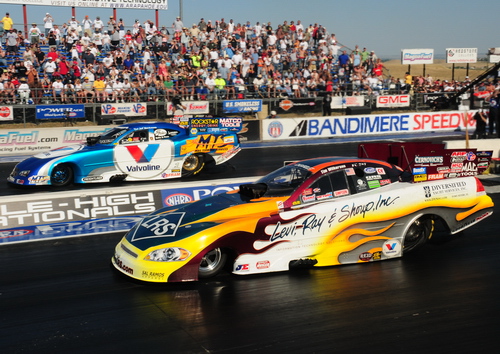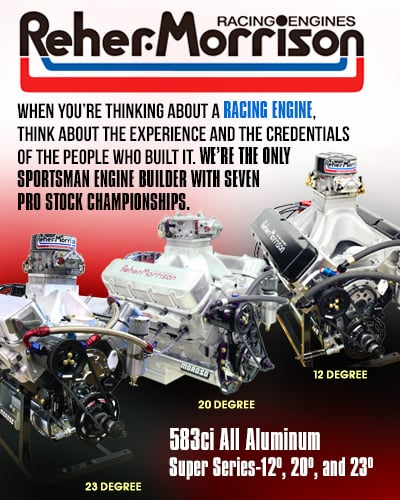DRIVERS RECALL WHEN NITRO RACING WENT TO 1,000-FEET BEGINNING AT BANDIMERE SPEEDWAY


This past weekend was emotional for racers and fans alike as the final Mile-High Nationals were contested at Bandimere Speedway in Morrison, Colo., near Denver.
There were countless memories in the 65 years of racing at Bandimere Speedway, especially at the 43 Mile-High Nationals events.
One historical moment came at the 2008 Mile-High Nationals. That was the first NHRA national event that Top Fuel dragsters and Funny Cars raced to 1,000-feet.
The move was precipitated by the tragic untimely death of popular world championship driver Scott Kalitta.
Kalitta was killed in an accident where his out-of-control Funny Car ran off the end of Old Bridge Township Raceway Park in Englishtown, N.J., on June 21, 2008, during the final round of qualifying at the Lucas Oil NHRA SuperNationals.
Because the Englishtown shutdown area was among the shortest on the NHRA tour, the conversation to run 1,000-feet began as early as the Sunday of the event.
The following week in Norwalk, Ohio, the Summit Racing Equipment NHRA Nationals was run at a quarter-mile distance. On that Sunday, June 29, 2008, the last quarter-mile NHRA nitro national event was contested.
The 2008 Mopar Mile-High Nationals, the next race on the circuit – July 11-13 – was the first race of the 1,000-foot era.
A trio of NHRA drivers talked to CompetitionPlus.com about that historic race where NHRA racing changed forever.
“I think we had our meetings there and they came to the conclusion that's what we were going to do,” said Capps, a three-time NHRA nitro Funny Car world champ in 2016, 2021-22. “I do remember how difficult it was at Denver, you would think as a driver that's driven these things a bunch, I'm speaking for a bunch of drivers, not just myself, on how easy it would be just to shut the car off a little earlier than what you're used to. I was shocked on how difficult it was to find the thousand foot (mark) and shut the cars off at a thousand foot that very first time.”

Capps remembered he wasn’t alone in trying to make a quick adaption to racing to 1,000-feet.

“(Gary) Scelzi, John Force, and just everybody, we were all gathering around the staging lanes and talking about how not so easy it was to shut them off at a thousand foot,” Capps said. “Then we thought, ‘Oh, we'll just go, and you'll know exactly where you're at and you'll click it off. I just remember it was difficult to see the scoreboards that we were used to shutting the cars off at and trying to shut them off early, being the first race that we were going to a thousand foot. It was much harder than we thought it was going to be.”
Veteran Top Fuel driver Clay Millican praised the move to 1,000-feet that was made in 2008, starting at the Mile-High Nationals.
“It's just second nature now and I can't imagine trying to run these cars a quarter mile anymore,” Millican said. “I see so many comments, especially on my YouTube stuff, ‘I miss the good old days of a quarter mile (racing).’ I don't ever really respond to that stuff, but everybody that says that doesn't drive one. You know what I mean?
“It's the way these things need to be run now because they go so fast. Some of the places we go, it's necessary because we need that extra 320 feet. And I guarantee you, if you told everybody that we are going back to a quarter mile, and you just run a thousand feet, probably 90 percent of the people there would not know the difference. I mean, they just wouldn't. The people that say that they're either old time racers or they're just people that don't understand just how fast these things are going now.”
Millican doesn’t believe quarter-mile racing for Top Fuel dragsters and nitro Funny Cars will happen again.
“It's crazy to think how fast they could possibly go, and that's certainly something that would be neat to find out,” Millican said. “But the tires just aren't made (for it). It's simple.”

Four-time world champion Top Fuel driver Steve Torrence, who made his Top Fuel debut in 2006, can’t believe 1,000-foot racing has been taking place for 15 years.
“Yeah, man, (it is crazy),” said Torrence, a winner of 53 Top Fuel Wallys. “I was at the race that Scott got killed at in '08. I can’t believe it has been that long since that happened, and we started racing to 1,000-feet.”
The winners of the first 1,000-foot race in NHRA history were Tony Schumacher (Top Fuel) and Tim Wilkerson (Funny Car).
Schumacher drove his U.S. Army dragster to a 4.007-second run at 304.05 mph to defeat runner-up Antron Brown to pick up what was his 47th career win.
“It’s still a good race,” said Schumacher, referring to the change to 1,000 feet at the time. “The key to this race was knowing it’s hot out, knowing that there’s water under the first 100 feet, and knowing that if you don’t get that car moving hard right there, you’re done, you’re not going to make it. And we knew that.”
Wilkerson drove his Levi Ray & Shoup Chevy Impala SS to a 4.398-second lap at 262.23 mph to defeat defending event winner Jack Beckman.






































